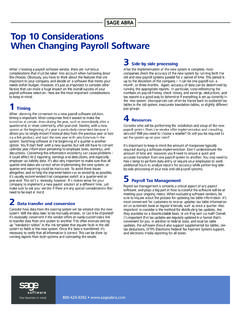Transcription of Security Operations Centers against cybercrime - EY
1 Insights on governance, risk and compliance October 2013. Security Operations Centers against cybercrime Top 10 considerations for success It is no longer a matter of if it is a matter of when.. With the understanding that attacks can never be fully prevented, companies should advance their detection capabilities so they can respond appropriately. Contents Introduction .. 1. A successful Security Operations center (SOC). builds on the basics .. 2. 1. Executive and board support .. 4. 2. Investment .. 5. 3. Strategy .. 6. 4. People .. 8. 5. Processes .. 8. 6. Technology .. 10. 7. Environment .. 12. 8. Analytics and reporting .. 13. 9. Physical space .. 13. 10. Continuous improvement .. 13. Conclusion .. 14. Introduction The face of information Security is changing at a rapidly accelerating rate. Information Security is changing at a rapidly accelerating rate. Hackers are increasingly relentless, making the response to information Security incidents an ever more complex challenge.
2 According to Under cyber attack; EY's Global Information Security Survey 2013*. (GISS), 59% of respondents have seen an increase in external threats in the last 12 months. In today's world of always-on technology and not enough Security awareness on the part of users, cyber attacks are no longer a matter of if but when. We live in an age where information Security prevention is not an option. Many organizations have made substantial progress in improving their defenses. In our most recent GISS survey, 60% of respondents believe that their Security Operations are mature. Point solutions, in particular antivirus, IDS, IPS, patching and encryption all show levels of maturity. These solutions remain a key control for combatting today's known attacks. However, they become less effective over time as hackers find new ways to circumvent controls. Preparing for known attacks is hard enough. But how do organizations build controls for the Security risks they don't even know about yet?
3 Leading organizations are doing more than improving on their current state. They are seeking to expand their efforts take bolder steps to combat cyber threats. Rather than waiting for the threats to come to them, these organizations are prioritizing efforts that enhance visibility and enable a proactive response through monitoring and prompt detection. Organizations may not be able to control when information Security incidents occur, but they can control how they respond to them. Expanding detection capabilities is the key place to start. A well-functioning Security Operations center (SOC) can form the heart of effective detection. It can enable information Security functions to respond faster, work more collaboratively and share knowledge more effectively. In the pages that follow, we explore the top 10 areas organizations need to consider to make their SOC a success. *How has the risk environment in which you operate changed in the last 12 months?
4 Choose all that apply. Increase in (external) threats 59%. No change in (internal) vulnerabilities 41%. Increase in (internal) vulnerabilities 34%. No change in (external) threats 29%. Decrease in (internal) vulnerabilities 15%. Decrease in (external threats) 7%. *Under cyber attack; EY's Global Information Security Survey 2013. Insights on governance, risk and compliance Security Operations Centers against cybercrime | 1. A successful SOC. builds on the basics 2 | Insights on governance, risk and compliance Security Operations Centers against cybercrime Start with the basics. It seems obvious enough. And yet, it's where organizations struggle the most. Forget the fancy tools and flashy rooms with large screens and biometric scanners in the entryway. They aren't the silver bullet that will protect you from the cyber threats outside or already inside your Security perimeter. At the core of a successful SOC is a strong foundation for operational excellence driven by well-designed and executed processes, strong governance, capable individuals and a constant drive for continuous improvement to stay ahead of the cyber adversaries.
5 A good SOC is one that supports business objectives and effectively improves a company's risk posture. A truly effective SOC is one that provides a safe environment for the business to deliver on its core objectives in line with its strategic direction and vision. Whether an organization is building a new SOC or looking to expand existing capabilities, here are 10 considerations for success: 1 Executive and board support 2 Investment 3 Strategy 4 People 5 Processes 6 Technology 7 Environment 8 Analytics and reporting 9 Physical space 10 Continuous improvement Insights on governance, risk and compliance Security Operations Centers against cybercrime | 3. The top 10 areas organizations need to consider to make their SOC a success 1 Executive and board support A bottom-up or grassroots approach to Security has a minimal chance of survival and an even smaller chance of success. Without clear executive support, a SOC may be ineffective, and its value will not be realized.
6 Creating an effective SOC requires support to establish a clear charter for the SOC and a long-term strategy, and also a strong SOC leader to drive organizational change and develop a culture of Security . Securing executive support In your quest to secure executive support, be ready to tell a compelling 65%. of information Security respondents in the story. Here is how you can structure this important discussion: Define problems and impact 2013 GISS cite budget constraints as their number one obstacle to delivering value Why do we need a SOC? to the business. What issues will the SOC solve for the organization? What must the SOC accomplish to solve the existing problems? Demonstrate vision What is your short-term vision? What is your long-term vision and how will you meet desired end-state maturity objectives? How does your vision align with business objectives, priorities and risk posture? Know what it takes How will you enable the success of the SOC?
7 What do you need in order to accomplish the SOC's objectives (people, process, technology, governance, etc.)? What should be done in-house and what can be outsourced? Figure out the price tag What is the required initial investment? What are the on-going costs of running/evolving a SOC? What are others spending in this space? Quantify the value How will you demonstrate the value of the SOC? 4 | Insights on governance, risk and compliance Security Operations Centers against cybercrime 2 Investment One of the most significant challenges SOCs can face is their ability to work (and succeed). within their often limited means, especially when they have not yet developed a track record 50%. of success or produced any tangible results. This is particularly difficult in an environment where a significant number of respondents in this year's GISS survey cite budget constraints as their number one obstacle to delivering value to the business. Within the limited means available, focus on acquiring the right talent.
8 Today's Information of GISS respondents also cited the lack of skilled resources as a barrier to value Security functions require a broad range of capabilities with a diversity of experiences. This creation. may be a difficult task, especially in less desirable geographic locations and given the overall scarcity of experienced SOC/incident response (IR) professionals in the industry. To attract the right talent, organizations will likely need to offer premium compensation and access to growth opportunities. SOC technology and the operating model will take another large bite from the budget. Open-source tools are free to use, but will require advanced practitioners to customize and operate them. Vendor-supported solutions are easy to use but come with expensive licensing and support fees. Given these two extremes, it's important to find the right balance that makes the most of limited funding. Allocate resources to secure some quick wins and demonstrate value to the business: this will lay the groundwork for increased investment in the future.
9 Say it and prove it The conversation around funding for Security monitoring and IR efforts must reach beyond IT and into the executive suite. Once the Information Security function has a seat at the table, it needs to tell a compelling story. Our experience indicates that board members are more convinced about the need to do something when the story includes: 1) An independent Security program review that can assess Security risk and overall maturity of the Security function 2) A scenario-based assessment that translates technical issues into high-impact business risks Broad-scale Security assessments can identify desired improvement opportunities based on overall maturity of the Security function and risk appetite of the organization. However, where traditional Security assessments can fall short is in making the findings relevant to the business. Benchmarks alone are no longer a compelling driver for change and maturity is a relative concept. Organizations also need to move beyond compliance and look at Security through the lens of performance and value.
10 Insights on governance, risk and compliance Security Operations Centers against cybercrime | 5. The top 10 areas organizations need to consider to make their SOC a success 3 Strategy A SOC must be able to clearly articulate its vision, mission and objectives within the context of three critical priorities: Alignment with overall risk posture Support of business goals Assistance in meeting compliance obligations To gain support and commitment, SOCs must serve as shared service Centers that deliver meaningful value to business stakeholders that aligns with their interests. As an inherently cross-functional organization, its introduction sometimes involves aggregating and centralizing existing Operations from disparate departments. The failure to intelligently reassign and reorganize these resources and processes represents a common pitfall that can jeopardize the success of a newly established SOC before it even commences Operations . To this end, organizations need to thoroughly define and formalize the SOC's governance and operating model (along with documented service-level agreements and processes).















